-
Welcome! The TrekBBS is the number one place to chat about Star Trek with like-minded fans.
If you are not already a member then please register an account and join in the discussion!
You are using an out of date browser. It may not display this or other websites correctly.
You should upgrade or use an alternative browser.
You should upgrade or use an alternative browser.
Props Re-used
- Thread starter Neroon
- Start date
- Status
- Not open for further replies.
Impressive, how many of those true-life tools were made in Chicago; 45-50 years ago, there was still a lot of manufacturing here.
I think the Crystal Tuning Fork Wrench Thing (CTFWT) was patterned after an old clutch wrench and sexed-up with crystals. See here for some new ones:
http://www.amazon.com/Lisle-41800-Piece-Clutch-Wrench/dp/B0002SRGWK
alchemist, those are made by Lisle Corporation, still manufacturing in Iowa: "Lisle Corporation will celebrate the company’s founding and 100 years of continuous manufacturing in Clarinda, Iowa in 2003. The privately owned company is led today by third, fourth and fifth generation family members..."
Iowa....hmmmmmmmmmm.alchemist, those are made by Lisle Corporation, still manufacturing in Iowa: "Lisle Corporation will celebrate the company’s founding and 100 years of continuous manufacturing in Clarinda, Iowa in 2003. The privately owned company is led today by third, fourth and fifth generation family members..."
Folks may heard the story of how Gene Roddenberry wanted some salt shakers for "The Man Trap"--which ended up not being appropriate for use as salt shakers--so Gene asked that they be pressed into service as medical and surgical instruments for Doctor McCoy.
Gene Roddenberry had this to say in the book The Making of Star Trek by Stephen E. Whitfield & Gene Roddenberry:
"In the very first show of our first season, ('The Man Trap' by George Clayton Johnson) we needed some salt shakers because we had a creature that craved salt, we had a story point which required the creature (disguised in human form) to give himself away when someone passed with a salt shaker on a tray. This posed a problem. What will a salt shaker look like three hundred years from now? Our property master, Irving Feinberg, went out and bought a selection of very exotic-looking salt shakers. It was not until after he brought them in and showed them to me that I realized they were so beautifully shaped and futuristic that the audience would never recognize them as salt shakers. I would either have to use 20th Century salt shakers or I would have to have a character say 'See, this is a salt shaker.' So I told Irving to go down to the studio commissary and bring me several of their salt shakers, and as he turned to go, I said 'However, those eight devices you have there will become Dr. McCoy's operating instruments.' For two years now, the majority of McCoy's instruments in Sick Bay have been a selection of exotic salt shakers, and we know they work, because we've seen them work. Not only has he saved many a life with them but it's helped keep our prop budget costs low."
(In truth, it appears that Gene actually miscounted. There were actually nine conical "devices" Irving Feinberg appears to have brought in.)
It would seem that Feinberg didn't actually obtain a "selection of very exotic-looking salt shakers." Rather, he obtained one set of salt and pepper shakers in a Danish Eames-era style and liked the general look of them so much, he had the Desilu machine shop fabricate seven additional similarly-shaped cone-things out of aluminum. Here's a typical salt and pepper shaker set from a recent ebay auction:

So, the entire set of these "devices" (original "shakers" and machined, custom-made cones) is:
One (1) Danish Eames-era salt shaker (with appropriate green paint job)
One (1) Danish Eames-era pepper shaker (with appropriate red paint job)
Two (2) identical flat-top custom fabricated cones
Two (2) identical pointy-top custom fabricated cones
Set of three (3) flat-top custom fabricated cones in three different sizes
You can see the entire set of nine devices in this third season publicity photo:
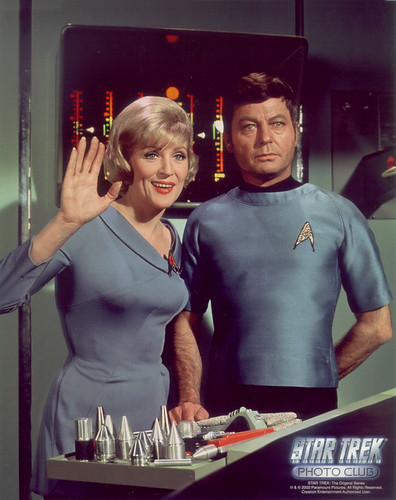
Of course, it's pretty much assumed that these things are scalpels. Doctor McCoy uses them in surgical operations and appears to be making incisions with them. Further, a photograph of these devices in The Making of Star Trek identifies them as scalpels. You can see the picture here:
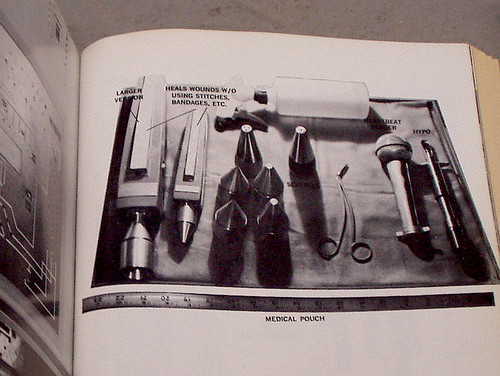
You can see these devices pretty much in all those episodes where a surgery is taking place. However, these "surgery" episodes generally show only six of the nine devices (and only six of the nine are shown in The Making of Star Trek). So it would appear likely that the extra set of three flat-top scalpels with the two concentric rings lathed into the bases might be some other kind of device with more Engineering-related applications. Here are some shots of the surgical/engineering devices--whatever they are:
"The Naked Time:"
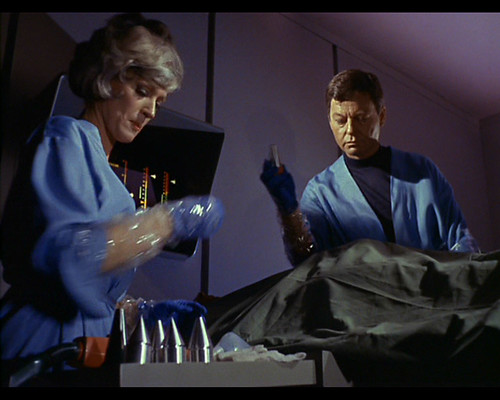
"Charlie X:"
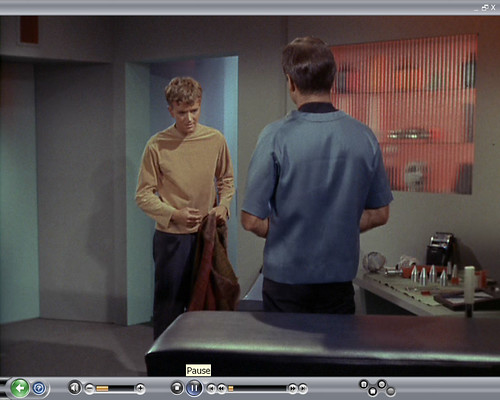
"Space Seed:"

"Operation--Annihilate!:"
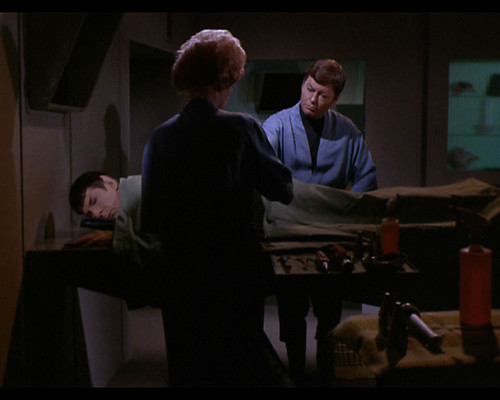
"Mirror, Mirror:"
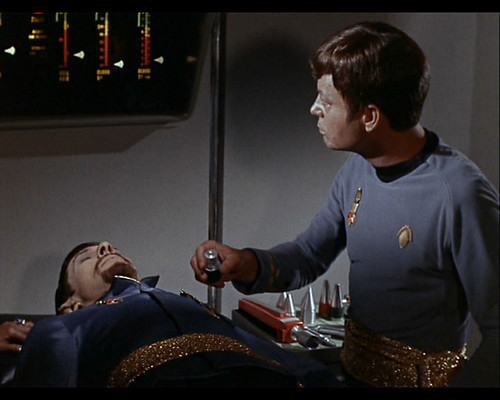
And here's a close-up of this "Mirror, Mirror" screen shot where you can make out the red-orange color and the green color on the two "real" salt shakers:
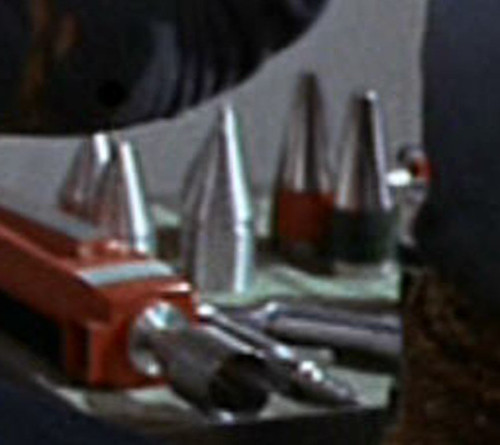
"Journey to Babel:"
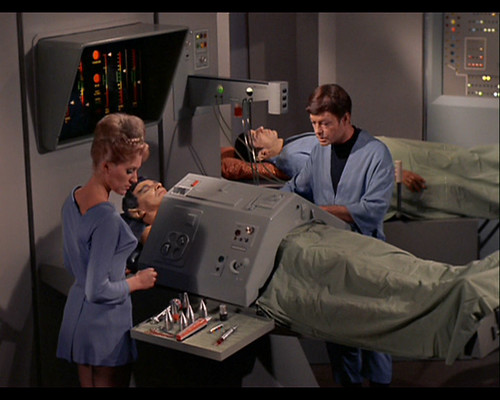
And here's a close-up of this "Journey to Babel" screenshot. You can see all kinds of interesting medical props--including a few of the scalpels:

"A Private Little War:"
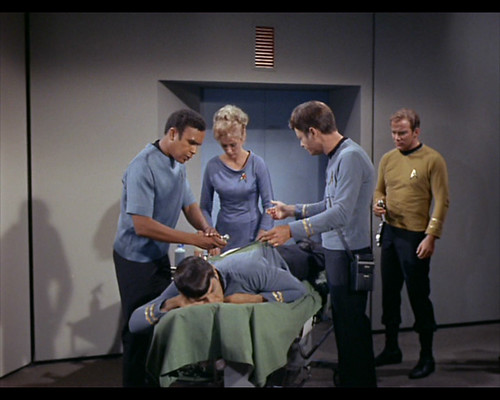
"Elaan of Troyius:"
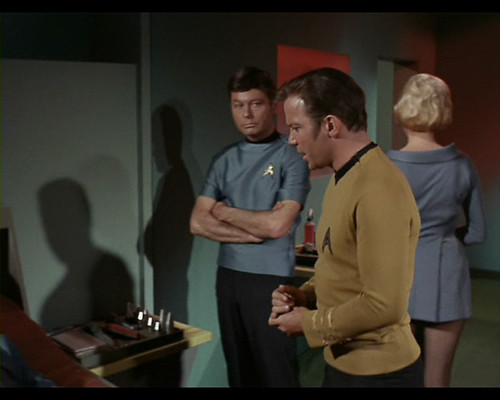
"The Enterprise Incident:"

And here are a couple of those instances where we see the three slightly different shaped devices in some non-surgical related contexts.
In "The Omega Glory," Doctor McCoy has them down with him on planet Omega IV--where presumably he's not doing any surgeries:
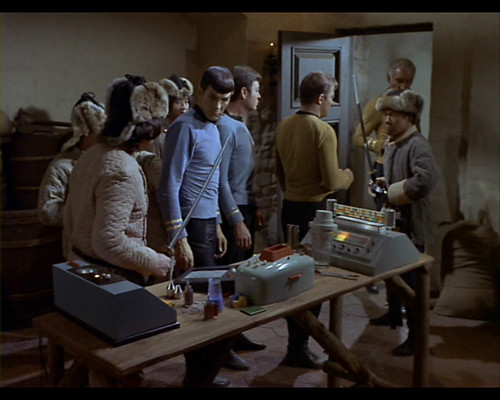
In "Return to Tomorrow," Sargon and Thalassa use them in their project to create android bodies for themselves and you can see them sitting on the workbench:
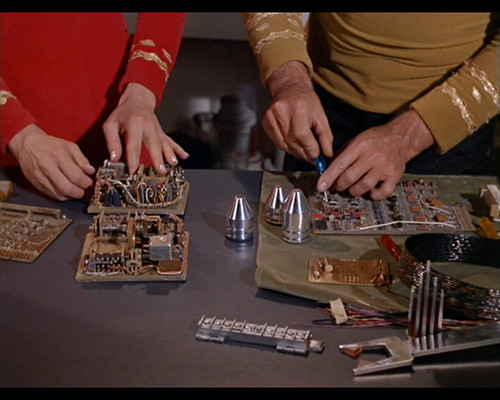
In "The Ultimate Computer," Mr. Scott uses one to try to bypass the M-5 computer:
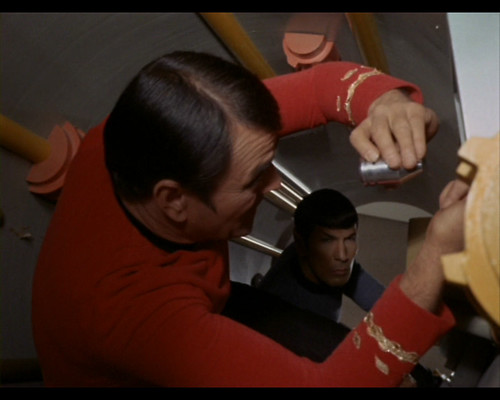
At any rate, here is my complete set of nine insturments--the six surgical scalpels and the three other (possibly Engineering-related) ones:

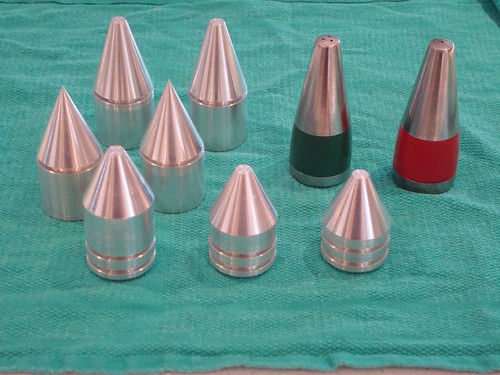
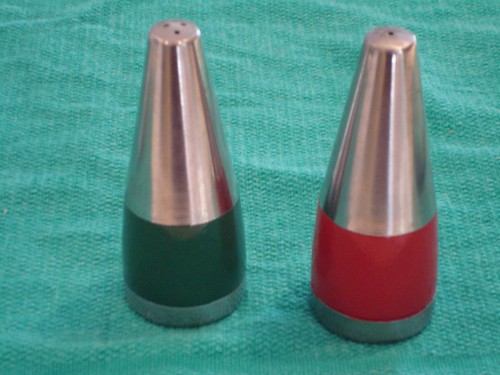
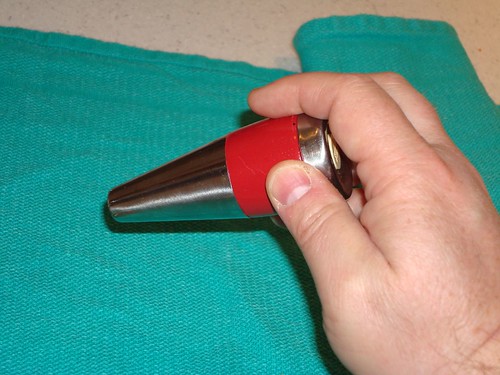
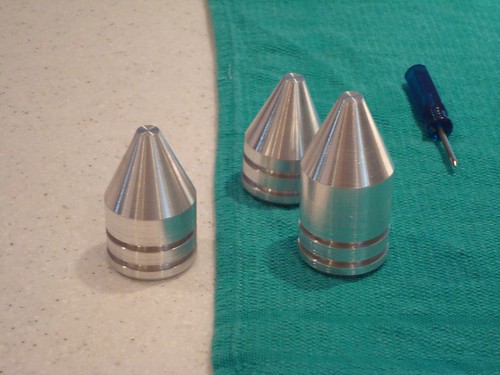
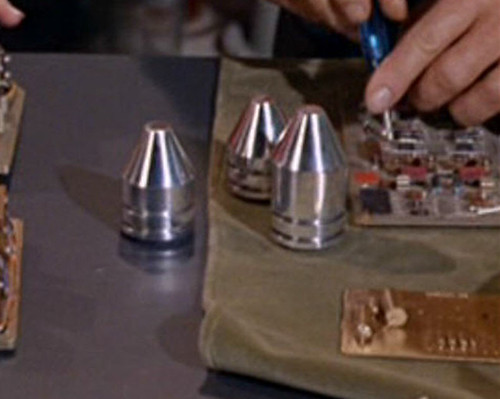
So we might see these devices sometime in Star Trek: Phase II--either as a surgical device or possibly as some kind of engineering tool.
See the slide show at:
http://www.flickr.com/photos/10901121@N06/sets/72157603205779420/show/
Gene Roddenberry had this to say in the book The Making of Star Trek by Stephen E. Whitfield & Gene Roddenberry:
"In the very first show of our first season, ('The Man Trap' by George Clayton Johnson) we needed some salt shakers because we had a creature that craved salt, we had a story point which required the creature (disguised in human form) to give himself away when someone passed with a salt shaker on a tray. This posed a problem. What will a salt shaker look like three hundred years from now? Our property master, Irving Feinberg, went out and bought a selection of very exotic-looking salt shakers. It was not until after he brought them in and showed them to me that I realized they were so beautifully shaped and futuristic that the audience would never recognize them as salt shakers. I would either have to use 20th Century salt shakers or I would have to have a character say 'See, this is a salt shaker.' So I told Irving to go down to the studio commissary and bring me several of their salt shakers, and as he turned to go, I said 'However, those eight devices you have there will become Dr. McCoy's operating instruments.' For two years now, the majority of McCoy's instruments in Sick Bay have been a selection of exotic salt shakers, and we know they work, because we've seen them work. Not only has he saved many a life with them but it's helped keep our prop budget costs low."
(In truth, it appears that Gene actually miscounted. There were actually nine conical "devices" Irving Feinberg appears to have brought in.)
It would seem that Feinberg didn't actually obtain a "selection of very exotic-looking salt shakers." Rather, he obtained one set of salt and pepper shakers in a Danish Eames-era style and liked the general look of them so much, he had the Desilu machine shop fabricate seven additional similarly-shaped cone-things out of aluminum. Here's a typical salt and pepper shaker set from a recent ebay auction:

So, the entire set of these "devices" (original "shakers" and machined, custom-made cones) is:
One (1) Danish Eames-era salt shaker (with appropriate green paint job)
One (1) Danish Eames-era pepper shaker (with appropriate red paint job)
Two (2) identical flat-top custom fabricated cones
Two (2) identical pointy-top custom fabricated cones
Set of three (3) flat-top custom fabricated cones in three different sizes
You can see the entire set of nine devices in this third season publicity photo:

Of course, it's pretty much assumed that these things are scalpels. Doctor McCoy uses them in surgical operations and appears to be making incisions with them. Further, a photograph of these devices in The Making of Star Trek identifies them as scalpels. You can see the picture here:

You can see these devices pretty much in all those episodes where a surgery is taking place. However, these "surgery" episodes generally show only six of the nine devices (and only six of the nine are shown in The Making of Star Trek). So it would appear likely that the extra set of three flat-top scalpels with the two concentric rings lathed into the bases might be some other kind of device with more Engineering-related applications. Here are some shots of the surgical/engineering devices--whatever they are:
"The Naked Time:"

"Charlie X:"

"Space Seed:"

"Operation--Annihilate!:"

"Mirror, Mirror:"

And here's a close-up of this "Mirror, Mirror" screen shot where you can make out the red-orange color and the green color on the two "real" salt shakers:

"Journey to Babel:"

And here's a close-up of this "Journey to Babel" screenshot. You can see all kinds of interesting medical props--including a few of the scalpels:

"A Private Little War:"

"Elaan of Troyius:"

"The Enterprise Incident:"

And here are a couple of those instances where we see the three slightly different shaped devices in some non-surgical related contexts.
In "The Omega Glory," Doctor McCoy has them down with him on planet Omega IV--where presumably he's not doing any surgeries:

In "Return to Tomorrow," Sargon and Thalassa use them in their project to create android bodies for themselves and you can see them sitting on the workbench:

In "The Ultimate Computer," Mr. Scott uses one to try to bypass the M-5 computer:

At any rate, here is my complete set of nine insturments--the six surgical scalpels and the three other (possibly Engineering-related) ones:






So we might see these devices sometime in Star Trek: Phase II--either as a surgical device or possibly as some kind of engineering tool.
See the slide show at:
http://www.flickr.com/photos/10901121@N06/sets/72157603205779420/show/
Great information (as always), Greg. I'm especially impressed with the accurate recreations of McCoy's medical devices. Were these specially turned for you or did you find some pre-made source?
The two scalpels that were Stelton Danish Modern salt and pepper shakers were, well, Stelton Danish Modern salt and pepper shakers. My other seven were custom turned aluminum--lathed from scratch; they weren't found items.
There is a prop we saw four times in The Original Series. It's a billfold-envelope-thing that Captain Kirk generally keeps in the "safe" in his quarters.
The script for "What Are Little Girls Made Of?" indicates that Mister Spock asks Captain Kirk "You're going back down with the Command Pack?" To which Kirk replies "Mind your own business Mister Spock. I'm sick of your half-breed interference, do you hear?" So evidently, according to Mister Spock, this document holder envelope thing is called a "Command Pack."
We see the Command Pack four times:
It's in "What Are Little Girls Made Of?" (It's in Kirk's left hand, a little hard to see.)

It's in "The Menagerie, Part 1."
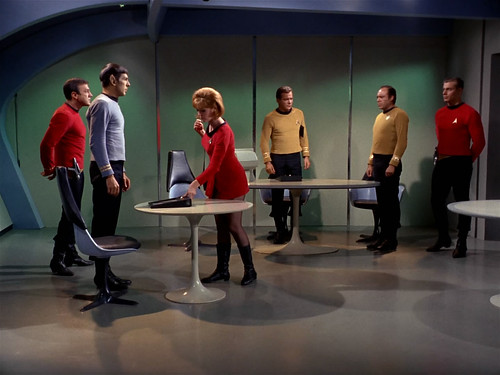
(It's under Kirk's arm--which is the best shot of it at the TrekCore web site--although there's a shot a few moments later in the episode that's a little bit better. Kirk places it on the tabletop between him and the "log book" PADD thing. It's this appearance of the Command Pack from "The Menagerie" that most people overlook--the one where it appears not in the context of Kirk's wall safe in his quarters.)
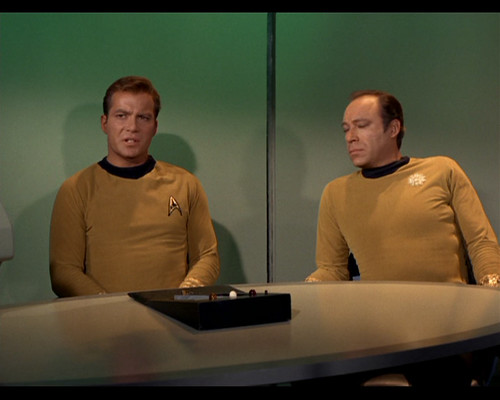

It's in "This Side of Paradise."


Lastly, it's in "The Tholian Web."
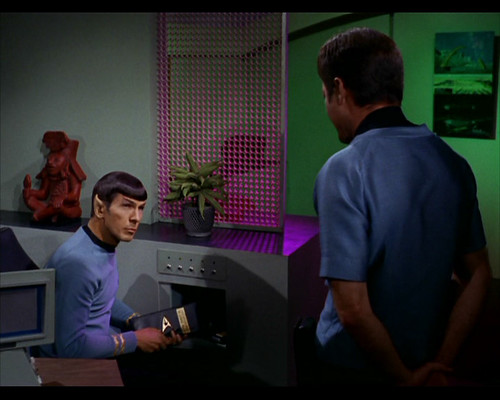
The appearance of the Command Pack in "The Tholian Web" is a bit different. It seems to have some kind of label or identification plate on the front of the Pack alongside the command insignia.
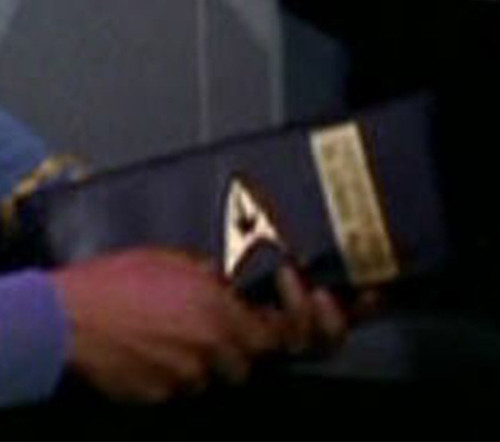
Also, clearly identifiable in "The Tholian Web" when Mister Spock tosses the yellow "Final Orders" data tape card thing back into the pack is the fact that the pack actually has an envelope-style triangular flap back. So it isn't just a bi-fold like a checkbook. It's a leather or vinyl envelope:
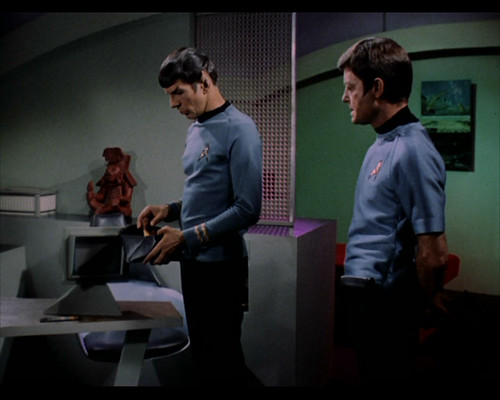
So, here's my leather Command Pack as seen in "What Are Little Girls Made Of?" and "The Menagerie, Part 1" and "This Side of Paradise:"

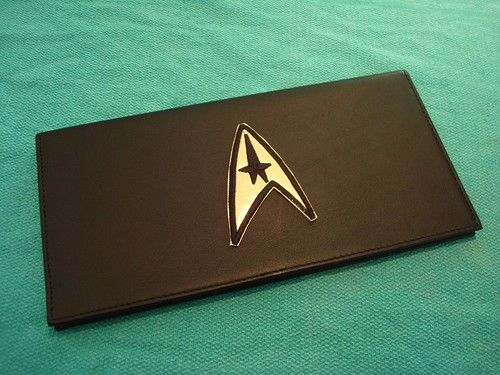
You can see that it has an envelope-style back:
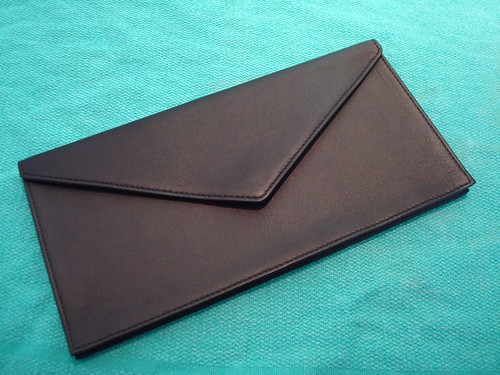
Here's the Command Pack in its "The Tholian Web" incarnation:

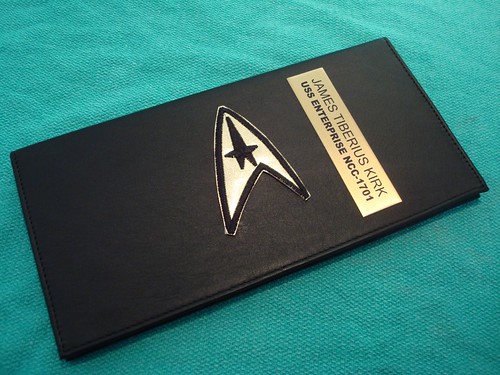
...and Captain Kirk's "Final Orders" tape deck card:
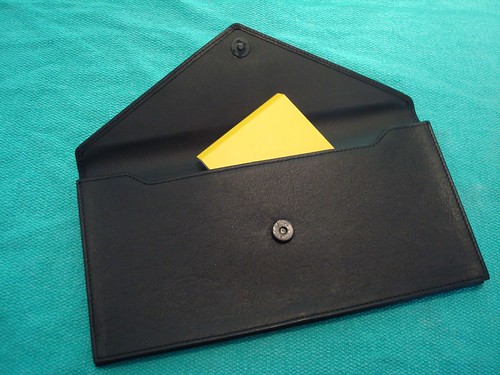
And both Command Packs together:

Actually, the above pictures are a couple of months old. But just the other day, I got a couple of new command patches that are more screen accurate. I replaced the patches on the command packs with my newer patches. Here's a more recent shot:
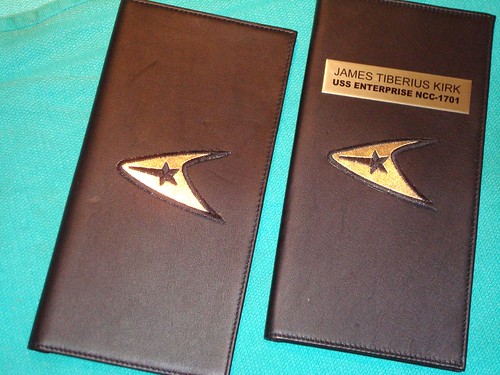
Slide show is here:
http://flickr.com/photos/10901121@N06/sets/72157610466301591/show/
The script for "What Are Little Girls Made Of?" indicates that Mister Spock asks Captain Kirk "You're going back down with the Command Pack?" To which Kirk replies "Mind your own business Mister Spock. I'm sick of your half-breed interference, do you hear?" So evidently, according to Mister Spock, this document holder envelope thing is called a "Command Pack."
We see the Command Pack four times:
It's in "What Are Little Girls Made Of?" (It's in Kirk's left hand, a little hard to see.)

It's in "The Menagerie, Part 1."

(It's under Kirk's arm--which is the best shot of it at the TrekCore web site--although there's a shot a few moments later in the episode that's a little bit better. Kirk places it on the tabletop between him and the "log book" PADD thing. It's this appearance of the Command Pack from "The Menagerie" that most people overlook--the one where it appears not in the context of Kirk's wall safe in his quarters.)


It's in "This Side of Paradise."


Lastly, it's in "The Tholian Web."

The appearance of the Command Pack in "The Tholian Web" is a bit different. It seems to have some kind of label or identification plate on the front of the Pack alongside the command insignia.

Also, clearly identifiable in "The Tholian Web" when Mister Spock tosses the yellow "Final Orders" data tape card thing back into the pack is the fact that the pack actually has an envelope-style triangular flap back. So it isn't just a bi-fold like a checkbook. It's a leather or vinyl envelope:

So, here's my leather Command Pack as seen in "What Are Little Girls Made Of?" and "The Menagerie, Part 1" and "This Side of Paradise:"


You can see that it has an envelope-style back:

Here's the Command Pack in its "The Tholian Web" incarnation:


...and Captain Kirk's "Final Orders" tape deck card:

And both Command Packs together:

Actually, the above pictures are a couple of months old. But just the other day, I got a couple of new command patches that are more screen accurate. I replaced the patches on the command packs with my newer patches. Here's a more recent shot:

Slide show is here:
http://flickr.com/photos/10901121@N06/sets/72157610466301591/show/
There was a device that Spock supposedly designed... can't remember the name of it. I think it might be called the Trident Scanner. You saw it in a few episodes, like in Metamorphosis (Spock was using it on the aft section of the shuttlecraft) or during a few scenes in the main engine room in several episodes, like The Ultimate Computer and The Doomsday Machine.
Anyway, this device was reused in a manner of speaking. The 3 "prongs" of the device were cannibalized and used for some sonic disruptor weapons in A Taste of Armageddon.
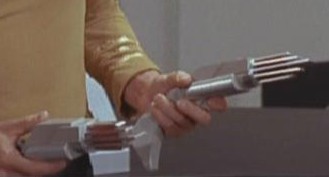


It even made a reappearance in DS9: Trials and Tribble-ations

Unless I'm mistaken, which is *highly* unlikely, this was known as the "Phynburg Oscillating Framizam"
I'm not kidding. Many of the props were given names based on Irving Feinberg, the prop master.
The term "ray-generator" first appears in the script for the episode "Metamorphosis" (which is where this prop makes its first appearance). "Metamorphosis" was the second episode filmed for Star Trek's second season. The script, written by Gene Coon, has this to say In Act II, Scene 39:
EXT. SHUTTLECRAFT – ANGLE ON SPOCK
He has a ray-generator of some sort in hand...
< snip >
So, the earliest reference to this device is as a "ray-generator." Later, Stephen Whitfield took pictures of this prop for his book The Making of Star Trek. In that book he called the device a "(Spock Built) Ray Generator and Energy Neutralizer." (Although there is no reference to Spock having cobbled this device together out of available components while the Galileo was stranded, perhaps Whitfield thought Spock did exactly that.)
<snip>
Greg Schnitzer
Property Master
Star Trek Phase II
Unless I'm mistaken, which is *highly* unlikely, this was known as the "Phynburg Oscillating Framizam"
I'm not kidding. Many of the props were given names based on Irving Feinberg, the prop master.
Kirk here, I like fun names, especially one better than a "ray generator", but would you care to give us some documentation on this? Greg has.
The term "ray-generator" first appears in the script for the episode "Metamorphosis" (which is where this prop makes its first appearance). "Metamorphosis" was the second episode filmed for Star Trek's second season. The script, written by Gene Coon, has this to say In Act II, Scene 39:
EXT. SHUTTLECRAFT – ANGLE ON SPOCK
He has a ray-generator of some sort in hand...
< snip >
So, the earliest reference to this device is as a "ray-generator." Later, Stephen Whitfield took pictures of this prop for his book The Making of Star Trek. In that book he called the device a "(Spock Built) Ray Generator and Energy Neutralizer." (Although there is no reference to Spock having cobbled this device together out of available components while the Galileo was stranded, perhaps Whitfield thought Spock did exactly that.)
<snip>
Greg Schnitzer
Property Master
Star Trek Phase II
Unless I'm mistaken, which is *highly* unlikely, this was known as the "Phynburg Oscillating Framizam"
I'm not kidding. Many of the props were given names based on Irving Feinberg, the prop master.
Kirk here, I like fun names, especially one better than a "ray generator", but would you care to give us some documentation on this? Greg has.
The "Star Trek Concordance" by Dorothy Jones (edited by Bjo Trimble), page 64. It is accompanied by a sketch that is *similar* to the prop in question. Also, this name is used in one of the following books: The Making of Star Trek, Star Trek Lives!, or The Trouble With Tribbles. These are the only "ST history books" I've read (back in the mid-70s).
BTW, the odd-shaped colored blocks were referred to a "Feinberg Blocks" (same ref. page 42, and same books).
In addition, the generic terms "Feinberger" and "Irvingoscope" were used for equipment (page 42 and 48).
Just BFD, or FYI, or whatever.
;o)
The term "ray-generator" first appears in the script for the episode "Metamorphosis" (which is where this prop makes its first appearance). "Metamorphosis" was the second episode filmed for Star Trek's second season. The script, written by Gene Coon, has this to say In Act II, Scene 39:
EXT. SHUTTLECRAFT--ANGLE ON SPOCK
He has a ray-generator of some sort in hand...
< snip >
So, the earliest reference to this device is as a "ray-generator." Later, Stephen Whitfield took pictures of this prop for his book The Making of Star Trek. In that book he called the device a "(Spock Built) Ray Generator and Energy Neutralizer." (Although there is no reference to Spock having cobbled this device together out of available components while the Galileo was stranded, perhaps Whitfield thought Spock did exactly that.)
<snip>
Greg Schnitzer
Property Master
Star Trek Phase II
Unless I'm mistaken, which is *highly* unlikely, this was known as the "Phynburg Oscillating Framizam"
I'm not kidding. Many of the props were given names based on Irving Feinberg, the prop master.
Kirk here, I like fun names, especially one better than a "ray generator", but would you care to give us some documentation on this? Greg has.
Well, Kirk here actually is incorrect--and it could indeed be because Bjo's information was incorrect. (It sounds like Dorothy Jones and Bjo simply have a wrong sketch assigned to this entry in her old book. Her more recent edition of the Concordance doesn't have this error.) The term "Phynburg Oscillating Framizam" occurs in just one Star Trek script ("Charlie X"--in the first season)--and it relates to a different prop. The name doesn't relate to the "ray generator" prop; the "ray generator" prop wasn't built until the second season.
The Memory Alpha website has this comment about the Concordance:
http://memory-alpha.org/en/wiki/Star_Trek_Concordance
"Unfortunately there are mistakes throughout the book, especially in the cast lists. These lists were copied to the later editions of the Star Trek Encyclopedia with the errors remaining. This has also led to fan sites listing incorrect information. There is no word on whether of not these errors were corrected in the updated release."
At any rate, here's a bit more information on the "Phynburg Oscillating Framizam" prop:
We've seen on occasion how some props get re-purposed for different uses. One such example is something that has come to be known as a medical "anabolic protoplaser," although the prop's first appearance in Star Trek is actually as some kind of Engineering tool.
This red, black, and silver device is first seen in Star Trek in the episode "Charlie X." The "Charlie X" script has a character identified simply as "Crewman I" holding this thing as he climbs down out of the Jefferies Tube. Here's the content from Act I, Scene 21:
THE TUBE
As Charlie backs out of the tube--straightens--backs
off a step. A fraction of a beat later, the Crewman
deftly climbs out--and a half beat later comes yet again
another Crewman--the former carries a Phynburg
Oscillating Framizam--the latter carries an Irving-
oscope. Crewman I takes his partner's Irvingoscope.
CREWMAN I
I'll put the equipment away.
See you in the Rec. room.
CREWMAN II
(slaps his partner on
The keester with the back of his hand as
he goes)
You got a deal, friend.
And Charlie watches. Crewman I delays a beat to check
the readings on his Framizam--realizes Charlie is
there in b.g.
CREWMAN I
Hello.
Charlie smiles--Crewman I moves on--Charlie records
all he has seen in his mind--puzzles on it some--
moves on--EXITS
Here's a screen grab from this scene of Crewman I holding the "Phynburg Oscillating Framizam" prop:

At any rate, the point of all this is that the script calls this thing a "Phynburg Oscillating Framizam" and the other prop in this scene held by Crewman II--who is still in the Jefferies tube (and which we won't get into here) is an "Irvingoscope." Of course, these are both studio in-jokes. Irving Feinberg was the Property Master on Star Trek and was responsible for procuring and maintaining all the props. This is the one and only script where this "Phynburg Oscillating Framizam" term is used and, despite what the old Concordance might say, relates to this red, black and silver doohickey.
The next time we see this prop, Captain Kirk has it. He's helping some crewman with repair work over at Mr. Scott's Engineering station on the bridge at the very beginning of the Teaser of "What Are Little Girls Made Of?" and he carries the prop around and even noodles with it while sitting in his command chair.
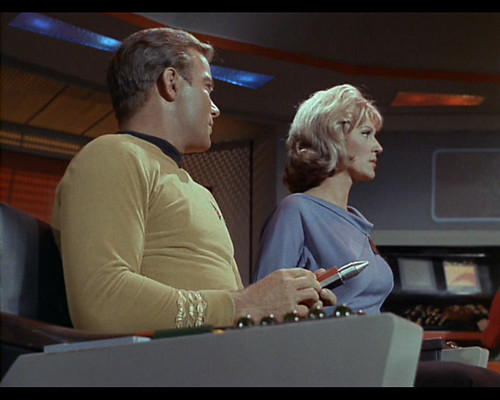
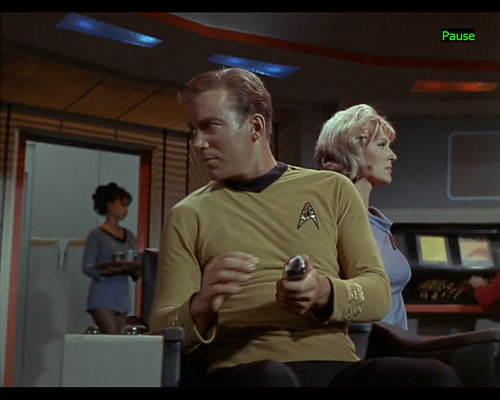
After that appearance, it seems to have been decided that this prop should be some kind of medical device. All other appearances seem to be in medical contexts.
We see Dr. McCoy using it in "Space Seed" to help revive Khan Noonian Singh:
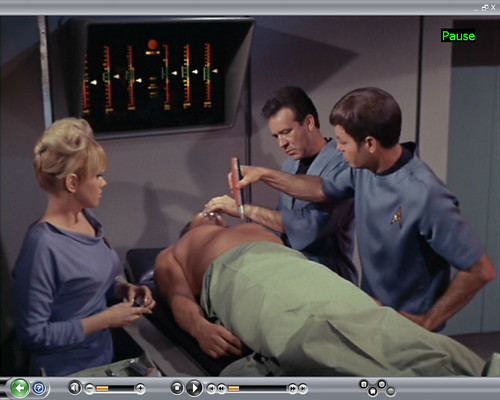
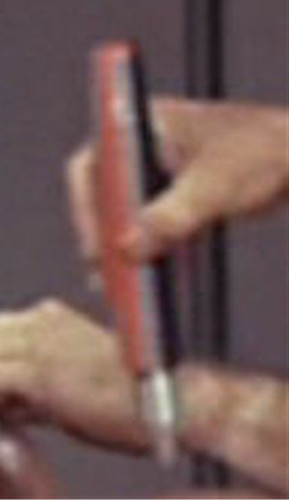
We see it next to Kirk's bed in the Sick Bay Ward Room in "The Deadly Years:"
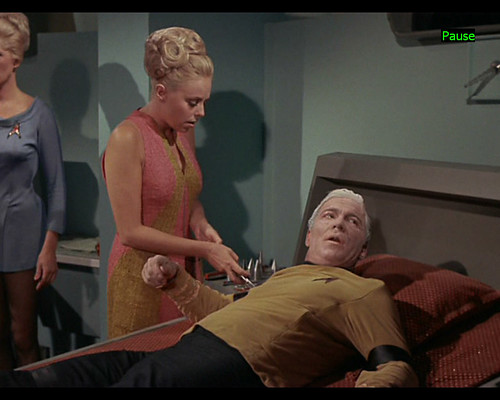
We see Dr. McCoy use it during Ambassador Sarek's surgery in "Journey to Babel:"

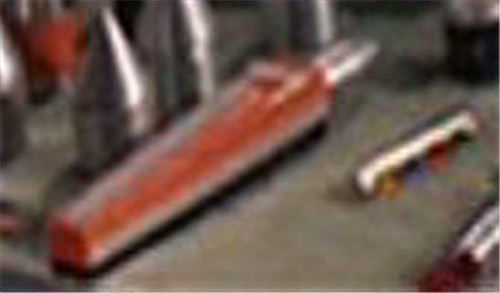
We see it next to the examination table in the Sick Bay Examination Room as Dr. McCoy, Nurse M'Benga, and some unnamed medical technician work on Kirk/Sargon in "Return to Tomorrow:"
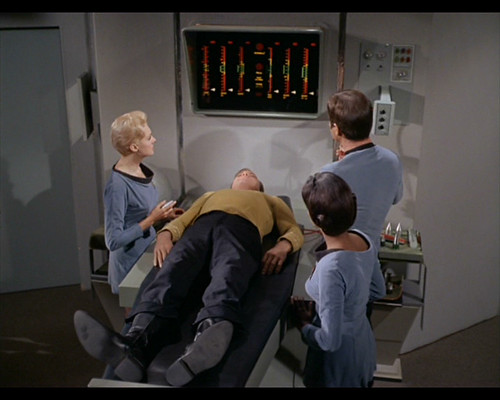
We see it in just about the exact same place as Dr. McCoy works on the brainless Mister Spock in "Spock's Brain:"

We see it in "Elaan of Troyius:"

We see it in the "Emergency Surgical Kit" that Nurse Christine Chapel brings with her down to the surface of the planet Amerind to help treat Kirk/Kirok in "The Paradise Syndrome:"
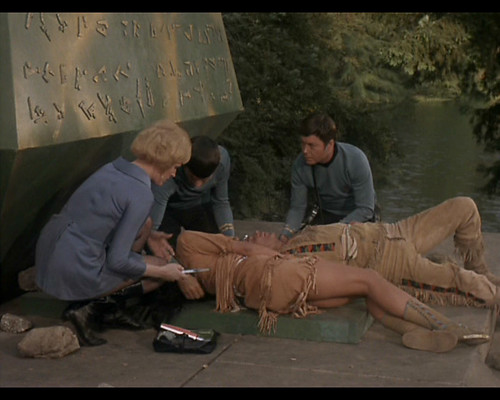
And we see it in a series of Third Season publicity photos taken with DeForest Kelley and Majel Barrett in the Sick Bay Examination Room:
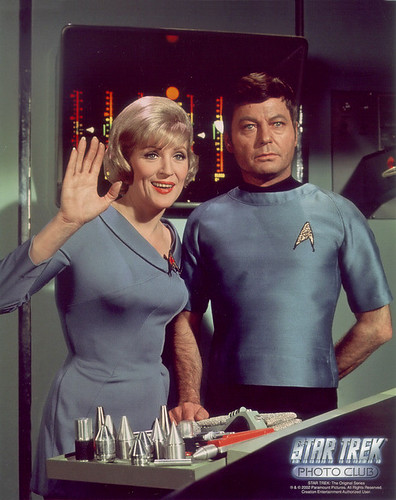
So, although it started life as some kind of Engineering related "Phynburg Oscillating Framizam," what is it now? Well, they never called it by name but the book The Making of Star Trek by Stephen Whitfield and Gene Roddenberry has a picture of the device and indicates that it "Heals wounds w/o using stitches, bandages, etc."
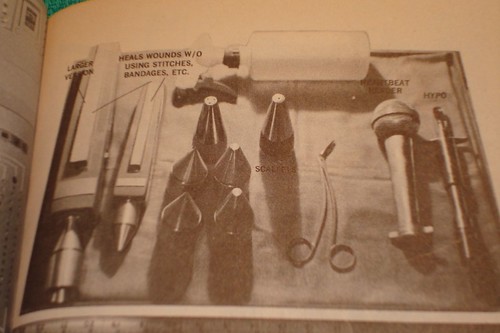
When Franz Joseph Schnaubelt wrote his now famous Star Fleet Technical Manual, he created reasonably accurate drawings of this device and called it an "Anabolic Protoplaser."
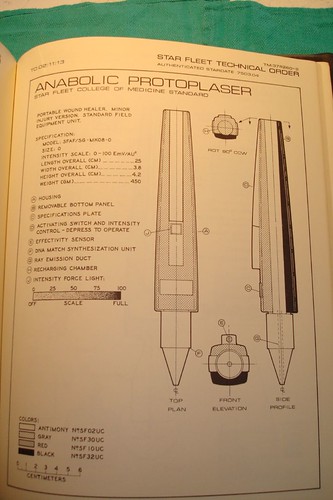
Here are some shots of my Phynburg Oscillating Framizam/Anabolic Protoplaser prop reproduction:
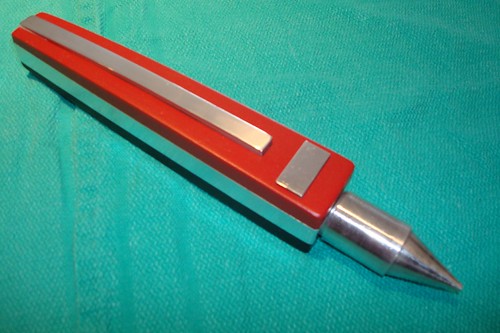
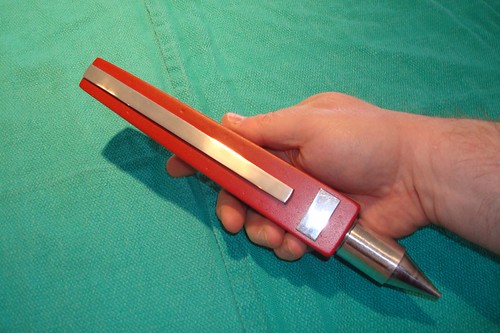
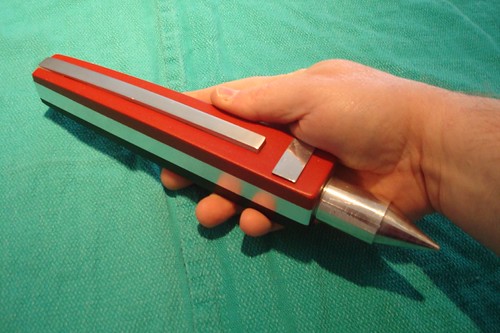

Slide show is at:
http://www.flickr.com/photos/10901121@N06/...221192469/show/[/url]
Last edited:
I always thought it rather cool that the 3' model of the Enterprise was used as a show-prop in Requiem for Methuselah. Nice to see the actors in the same shot as the E, though in shrunken form.
http://tos.trekcore.com/gallery/albums/3x19/requiemformethuselah_383.jpg
http://tos.trekcore.com/gallery/albums/3x19/requiemformethuselah_391.jpg
Does anyone know the history of this model? Why it was made and its fate? Is this the same model that Nimoy is holding in some early promo shots?
http://tos.trekcore.com/gallery/albums/3x19/requiemformethuselah_383.jpg
http://tos.trekcore.com/gallery/albums/3x19/requiemformethuselah_391.jpg
Does anyone know the history of this model? Why it was made and its fate? Is this the same model that Nimoy is holding in some early promo shots?
When Franz Joseph Schnaubelt wrote his now famous Star Fleet Technical Manual, he created reasonably accurate drawings of this device and called it an "Anabolic Protoplaser."

This prop was re-created for ST:TMP based on FJ's size and color spec's, you can see Dr. Chapel with it in sickbay when Spock is recovering from his incounter with V'ger.
When Franz Joseph Schnaubelt wrote his now famous Star Fleet Technical Manual, he created reasonably accurate drawings of this device and called it an "Anabolic Protoplaser."

This prop was re-created for ST:TMP based on FJ's size and color spec's, you can see Dr. Chapel with it in sickbay when Spock is recovering from his incounter with V'ger.
Well, I don't think that's exactly correct.
There was indeed one of these "anabolic protoplaser"-type devices used by Dr. Chapel in The Motion Picture, but I'm not sure how closely it adhered to Franz Joseph Schnaubelt's interpretation of the device from his Technical Manual.
You can see a shot of it here:

Not long ago, this prop was sold at the "Profiles in History" auction. Here's a shot from the auction catalog:

Between the TMP screen capture and this catalog picture, you can see that it doesn't adhere strictly to the FJ interpretation in a few ways:
1. The prop is black on the both the top and the bottom--not gray on the top like the FJ design.
2. The middle silver-colored rib is wider on the prop than on the FJ design.
3. The end silver cone thing has some grooves cut into it, while the FJ design is smooth.
4. The small "specifications plate" (which had gotten lost by the time the prop came up for auction) is flush with the extreme lower edge of the device, while on the FJ version, the small plate is up a half inch or so from the bottom edge.
All in all, I think it's hard to say that the FJ design was any more the inspirational source of this TMP prop than the original TOS version was.
I always thought it rather cool that the 3' model of the Enterprise was used as a show-prop in Requiem for Methuselah. Nice to see the actors in the same shot as the E, though in shrunken form.
http://tos.trekcore.com/gallery/albums/3x19/requiemformethuselah_383.jpg
http://tos.trekcore.com/gallery/albums/3x19/requiemformethuselah_391.jpg
Does anyone know the history of this model? Why it was made and its fate? Is this the same model that Nimoy is holding in some early promo shots?
I think Shaw knows all of the details as he has made a rather extensive study of it that can be found here, but IIRC in brief it was not originally intended for actual effects use but was a proof-of-concept type 'prototype' for the big ole 11-footer. It didn't have any lights and was different in proportion and shape in several key areas from the 'final' design of the ship because its parts were apparently turned on a lathe. When the 11-footer wasn't finished in time, they ended up using the 3-footer for effects shots in 'The Cage' which ended up passing into the stock library.
After filming wrapped, the model was given to Gene and he kept it in his office for a while; according to Majel Barrett it was loaned to someone at some point and then lost, and they don't know what became of it.

Well, Kirk here actually is incorrect--and it could indeed be because Bjo's information was incorrect. (It sounds like Dorothy Jones and Bjo simply have a wrong sketch assigned to this entry in her old book. Her more recent edition of the Concordance doesn't have this error.)
It has been well documented that, unfortunately, there were errors in all versions of the Concordance.
Uhm, I believe this is a far too literal interpretation of the script. It is clear from internal memos between Roddenberry and Justman (see, for example, p. 342-346 of TMoST) that throw-away names (often times as jokes, as you noted) involving some form of Irving Feinberg's name were used to describe generic gadgets. Thus, "Irvingoscope" and "Phynberg oscillating Framizam" were simply scripted placeholders for two different gadgets used in the same scene. Interestingly, in the same script, and immediately before this scene, Charlie moves towards the foreground "...where a crewman is working on a wall unit with a Phynberg oscillating Framizam." This is the scene where Charlie watches the crewman lower the rod (the directors likely interpretation of the Feinberg gadget) into the floor.At any rate, the point of all this is that the script calls this thing a "Phynburg Oscillating Framizam" and the other prop in this scene held by Crewman II--who is still in the Jefferies tube (and which we won't get into here) is an "Irvingoscope." Of course, these are both studio in-jokes. Irving Feinberg was the Property Master on Star Trek and was responsible for procuring and maintaining all the props. This is the one and only script where this "Phynburg Oscillating Framizam" term is used and, despite what the old Concordance might say, relates to this red, black and silver doohickey.
In the more modern Trek series, the word "TECH" was often used as a placeholder for a gadget.
Best,
Dave
Well, Kirk here actually is incorrect--and it could indeed be because Bjo's information was incorrect. (It sounds like Dorothy Jones and Bjo simply have a wrong sketch assigned to this entry in her old book. Her more recent edition of the Concordance doesn't have this error.)
It has been well documented that, unfortunately, there were errors in all versions of the Concordance.
Uhm, I believe this is a far too literal interpretation of the script. It is clear from internal memos between Roddenberry and Justman (see, for example, p. 342-346 of TMoST) that throw-away names (often times as jokes, as you noted) involving some form of Irving Feinberg's name were used to describe generic gadgets. Thus, "Irvingoscope" and "Phynberg oscillating Framizam" were simply scripted placeholders for two different gadgets used in the same scene. Interestingly, in the same script, and immediately before this scene, Charlie moves towards the foreground "...where a crewman is working on a wall unit with a Phynberg oscillating Framizam." This is the scene where Charlie watches the crewman lower the rod (the directors likely interpretation of the Feinberg gadget) into the floor.At any rate, the point of all this is that the script calls this thing a "Phynburg Oscillating Framizam" and the other prop in this scene held by Crewman II--who is still in the Jefferies tube (and which we won't get into here) is an "Irvingoscope." Of course, these are both studio in-jokes. Irving Feinberg was the Property Master on Star Trek and was responsible for procuring and maintaining all the props. This is the one and only script where this "Phynburg Oscillating Framizam" term is used and, despite what the old Concordance might say, relates to this red, black and silver doohickey.
In the more modern Trek series, the word "TECH" was often used as a placeholder for a gadget.
Best,
Dave
Well, no arguments from me. I don't for a moment believe these things are called "Phynburg Oscillating Framizams" in the Trek universe--and if we ever have dialog in our Phase II productions to identify these things, it will be a better term. These goofy names are indeed just script placeholders.
My only contention in all this is that while "Phynburg Oscillating Framizam" was indeed used in Trek scripts, at no time was the "ray generator"/"trident scanner" thing built in the second season used as a prop manifestation of a "Phynburg Oscillating Framizam" script direction.
- Status
- Not open for further replies.
Similar threads
- Replies
- 224
- Views
- 40K
- Replies
- 4
- Views
- 3K
Contest: ENTER
February 2025 Art Challenge - Suggest Your Themes!
- Replies
- 16
- Views
- 4K
Contest: ENTER
March 2025 Art Challenge - Suggest Your Themes!
- Replies
- 2
- Views
- 3K
If you are not already a member then please register an account and join in the discussion!

